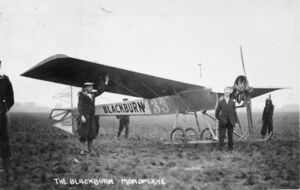Engineering:Blackburn Mercury
| Mercury | |
|---|---|

| |
| A Mercury at Hendon, 1912 | |
| Role | Trainer |
| Manufacturer | Blackburn Aeroplane Company |
| Designer | Robert Blackburn |
| First flight | 17 May 1911 |
| Number built | 9 |
| Developed from | Blackburn Second Monoplane |
The Blackburn Mercury was an early British aircraft designed as a pilot trainer for the Blackburn Flying School, Filey, in 1911. It was an enlarged, two-seat version of the Second Monoplane that flew earlier that year. It was a mid-wing monoplane of conventional configuration that accommodated pilot and student in tandem, open cockpits. This prototype was displayed at the Olympia Aero Show in March 1911, and led to orders being placed for two racers to participate in the Daily Mail Circuit of Britain race. The first of these crashed on takeoff, and the second was first rebuilt into a two-seat trainer, then into a single-seat trainer known as the Type B.[1] Another six Mercuries were built for various private buyers.
A full-scale non-flying replica of Mercury II configuration was constructed for the Yorkshire Television series Flambards and is now displayed at the Yorkshire Air Museum.
Variants
- Mercury I – two-seat prototype powered by Isaacson engine (one built)
- Mercury II – single-seat racer version with Gnome rotary engine (two built)
- Type B – one Mercury II converted to single-seat trainer
- Mercury III or Mercury Passenger Type – (six built) two-seaters powered by a variety of Isaacson, Gnome, Renault and Anzani engines
Specifications (Mercury I)
Data from Blackburn aircraft since 1909[2]
General characteristics
- Crew: 2
- Length: 33 ft 0 in (10.06 m)
- Wingspan: 38 ft 4 in (11.68 m)
- Height: 6 ft 9 in (2.06 m)
- Wing area: 288 sq ft (26.8 m2)
- Gross weight: 1,000 lb (454 kg)
- Powerplant: 1 × Isaacson 7-cylinder air-cooled radial piston engine, 50 hp (37 kW)
- Propellers: 2-bladed fixed-pitch propeller
Performance
- Maximum speed: 60 mph (97 km/h, 52 kn)
Notes
- ↑ "The Blackburn School Monoplane", p.1051. Though Flight refers to this aircraft as the Blackburn School monoplane, it is the Type B.
- ↑ Jackson, A.J. (1 April 1989). Blackburn aircraft since 1909. Naval Institute Press. pp. 60–71. ISBN 978-0870210242.
References
- "The Blackburn School Monoplane". Flight: 1048–51. 16 November 1912. http://www.flightglobal.com/pdfarchive/view/1912/1912%20-%201048.html. Retrieved 2009-02-23.
- Jackson, A.J. (1968). Blackburn Aircraft since 1909. London: Putnam.
- Taylor, Michael J. H. (1989). Jane's Encyclopedia of Aviation. London: Studio Editions. pp. 155.
- World Aircraft Information Files. London: Bright Star Publishing. pp. File 890 Sheet 31.
- Yorkshire Air Museum website
- Blackburn Mercury – British Aircraft Directory
 |


